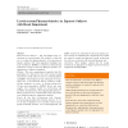Evaluation of hematuria using the urinary albumin-to-total-protein ratio to differentiate glomerular and nonglomerular bleeding.
Keywords
Abstract
BACKGROUND
Depending on the etiology and pathophysiology of hematuria, urinary bleeding is classified as glomerular hematuria or nonglomerular hematuria. Nephritis is usually detected by the presence of proteinuria, especially elevated albumin excretion. In this study, we report on the use of the urinary albumin-to-total-protein ratio to accurately differentiate glomerular and nonglomerular bleeding.
METHODS
A total of 143 fresh, random urine specimens demonstrating microscopic hematuria (5 or more red blood cells per high-power field) from patients with the source of the hematuria confirmed by histopathology and/or clinical criteria were included in the study.
RESULTS
Of the 143 specimens, 104 were from patients diagnosed with glomerular disease and 39 were from patients with nonglomerular disease. Corrected for urine concentration, the mean total-protein-to-creatinine (Cr) and albumin-to-Cr ratios in the glomerular disease group were 1.67 +/- 2.71 g/g Cr and 1.15 +/- 1.77 g/g Cr, respectively (P < 0.001). In the nonglomerular group, the mean total protein-to-Cr and albumin-to-Cr ratios were 0.19 +/- 0.23 g/g Cr and 0.05 +/- 0.06 g/g Cr, respectively (P < 0.001). However, considerable overlap in the ratios among glomerular and nonglomerular disease groups was observed. In contrast, the mean albumin-to-total protein ratios for glomerular and nonglomerular diseases were 0.72 +/- 0.10 and 0.35 +/- 0.17, respectively (P < 0.001). At a cutoff of 0.59, the albumin-to-total-protein ratio demonstrated a sensitivity of 97.1% (101 of 104 cases) in detecting glomerular disease.
CONCLUSIONS
The urinary albumin-to-total-protein ratio is potentially a useful index for the differentiation of glomerular and nonglomerular disease in the presence of microscopic hematuria.


